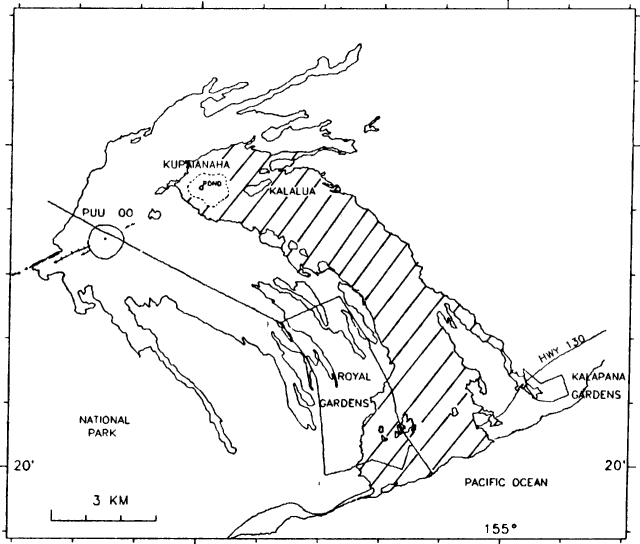Report on Kilauea (United States) — July 1989
Scientific Event Alert Network Bulletin, vol. 14, no. 7 (July 1989)
Managing Editor: Lindsay McClelland.
Kilauea (United States) High surface activity, new flow enters ocean
Please cite this report as:
Global Volcanism Program, 1989. Report on Kilauea (United States) (McClelland, L., ed.). Scientific Event Alert Network Bulletin, 14:7. Smithsonian Institution. https://doi.org/10.5479/si.GVP.SEAN198907-332010
Kilauea
United States
19.421°N, 155.287°W; summit elev. 1222 m
All times are local (unless otherwise noted)
. . . In July 1989, Kupaianaha's lava pond remained active, and filled by lava to within 25 m of its rim, which partially collapsed on the 9th and 13th. The earlier collapse (on the E rim) formed a talus pile near the bottom of the wall that was covered by lava, forming a 40 x 15 m ledge and altering the shape of the pond.
Lava continued to travel through the W tube system toward the coast in July (figure 63). Surface lava breakouts in the Wahaula area fed lobes that flowed from the lower Royal Gardens subdivision to the ocean (figure 61). On 5 July, lava advanced 150 m along Chain of Craters road, reaching the lower end of Prince Street (the westernmost street of the Royal Gardens subdivision) by the 23rd. A surface breakout from the W tube on the 21st at 320 m elevation (top of the pali fault scarp) reached 120 m elevation by the end of the month. The Kupapau flow that had entered the ocean on 22 June and then stagnated, reactivated 5-21 July. Flows that had merged and destroyed the visitor center on 20 June moved N and W of the Heiau (a religious site, several hundred years old), entering the ocean on 5 July. This flow, named Kailiili, remained active into early August, as did the Poupou flow, which had entered the ocean E of the Wahaula residential area on 23 June. Both flows built seacoast benches that were ~700 m long and actively growing (mostly westward) by the end of the month. The bench that began to form E of Kupapau Point in May 1988 remained active. On the 27th, a surface flow advanced over the sea cliff, covering the E half of the old bench. There were no collapses, and by the end of the month, the bench measured 200 x 50 m.
By the end of July, the number of aftershocks from the 25 June earthquake had decreased to near normal on Kīlauea's S flank. Most earthquakes were M 1.0-3.7, 5-15 km deep, and concentrated in a 45-km-long, NE-trending zone. The number of shallow earthquakes (<5 km) was above average in the East rift zone and slightly below average at Kīlauea's summit. Intermediate depth (5-15 km) long-period events continued. Low-level tremor near Pu`u `O`o and Kupaianaha had steady amplitudes, with episodic swarms of small high-frequency shocks near Kupaianaha and occasional rockfalls at Pu`u `O`o.
Geological Summary. Kilauea overlaps the E flank of the massive Mauna Loa shield volcano in the island of Hawaii. Eruptions are prominent in Polynesian legends; written documentation since 1820 records frequent summit and flank lava flow eruptions interspersed with periods of long-term lava lake activity at Halemaumau crater in the summit caldera until 1924. The 3 x 5 km caldera was formed in several stages about 1,500 years ago and during the 18th century; eruptions have also originated from the lengthy East and Southwest rift zones, which extend to the ocean in both directions. About 90% of the surface of the basaltic shield volcano is formed of lava flows less than about 1,100 years old; 70% of the surface is younger than 600 years. The long-term eruption from the East rift zone between 1983 and 2018 produced lava flows covering more than 100 km2, destroyed hundreds of houses, and added new coastline.
Information Contacts: C. Heliker and R. Koyanagi, HVO.


